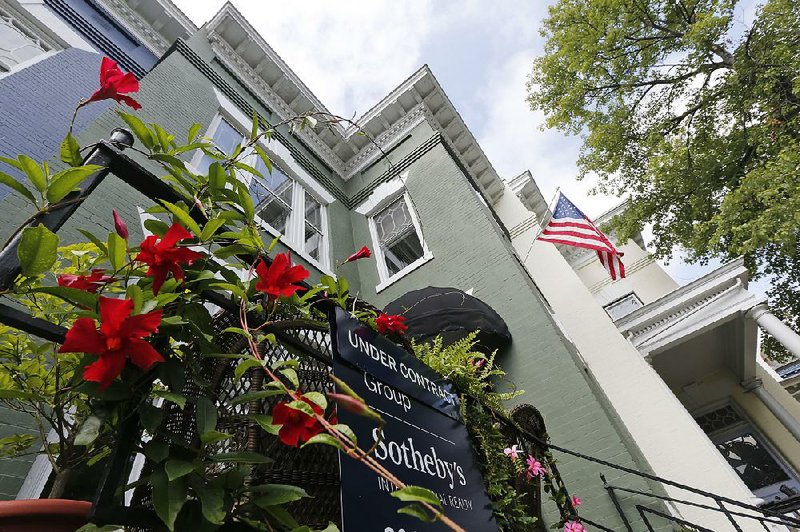WASHINGTON -- U.S. home sales rose 1.3% in August to the highest level in 17 months, as mortgage rates near historic lows have spurred a rush of homebuying.
The National Association of Realtors said Thursday that homes sold last month at a seasonally adjusted annualized rate of 5.49 million units, the best performance since March 2018. Sales have increased 2.6% from a year ago.
The recent bump in home sales is a sign of U.S. consumers' resilience despite a darkening outlook for growth. Lower borrowing costs have created an incentive to buy despite rising prices during a shortage of properties for sale.
"Consumers seem to still be confident in their finances, and are clearly feeling good enough to make large purchases such as buying a home," said John Pataky, executive vice president at TIAA Bank. "The prolonged period of low mortgage rates has helped pull buyers off the sidelines by making home purchases a more affordable proposition."
The median sales price climbed 4.7% from a year ago to $278,200, outpacing average wage gains.
Sales advanced in three of four regions, with the Northeast up 7.6% from the previous month, the South rising 0.9% and the Midwest increasing 3.1%. Purchases in the West fell 3.4%.
At the current pace, it would take 4.1 months to sell all the homes on the market, compared with 4.2 months in July; Realtors see anything below five months of supply as a sign of a tight market.
First-time buyers made up 31% of sales, down from 32% the previous month.
Existing-home sales account for about 90% of U.S. housing and are calculated when a contract closes. New-home sales, which make up the remainder, are counted when contracts are signed and will be released next week.
Homebuyers have been a beneficiary from the recent economic uncertainty, as interest rates have fallen in response to slower global growth and President Donald Trump's tariffs against China.
While the Federal Reserve cut interest rates this week, mortgage rates had their biggest one-week upturn in nearly a year.
According to data released Thursday by Freddie Mac, the 30-year fixed-rate average shot up to 3.73% with an average 0.5 point. (Points are fees paid to a lender equal to 1% of the loan amount and are in addition to the interest rate.) It returned to levels not seen since early August. The 30-year fixed-rate average was 3.56% a week ago.
The 15-year fixed-rate average climbed to 3.21% with an average 0.5 point. It was 3.09% a week ago and 4.11% a year ago. The five-year adjustable-rate average jumped to 3.49% with an average 0.4 point. It was 3.36% a week ago and 3.92% a year ago.
Despite this week's rise, the 30-year rate is down from 4.65% a year ago, when the higher government debt from Trump's tax cuts enabled borrowing costs to rise.
The upside is limited by a decline in sales listings. There were 1.86 million properties for sale at the end of August, down 2.6% from a year ago.
The inventory crunch appears to be most pronounced in starter homes priced below $250,000, the kinds of properties that are generally affordable for first-time buyers. Sales of homes worth less than $250,000 have fallen in the past year, while sales of homes priced between $250,000 and $1 million have risen.
The S&P 500 Index held on to its gains this week after the existing-home sales report and the Federal Reserve's decision on Wednesday to reduce its key lending rate.
A report Wednesday showed new-home construction surged in August to the fastest pace of the expansion as homebuilders started more apartment projects and single-family houses. Permits, which are often viewed as a proxy for future construction, rose to a 12-year high.
Separately, Labor Department figures Thursday showed filings for unemployment benefits remained near a half-century low last week, suggesting the job market is still healthy. Americans' sentiment also held close to an 18-year high, according to Bloomberg Consumer Comfort Index data.
The home-sales data show the market may have "just turned a corner for consistent gains in the upcoming months, particularly given that we are essentially at historically low mortgage rates," Lawrence Yun, the Realtors association's chief economist, said at a briefing in Washington.
Information for this article was contributed by Josh Boak of The Associated Press; by Reade Pickert and Jordan Yadoo of Bloomberg News; and by Kathy Orton of The Washington Post.
Business on 09/20/2019

